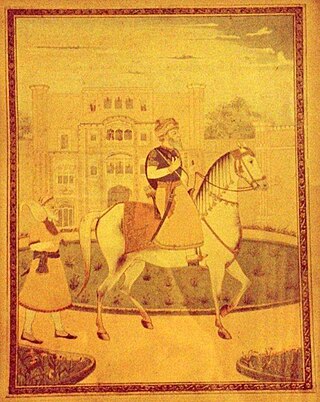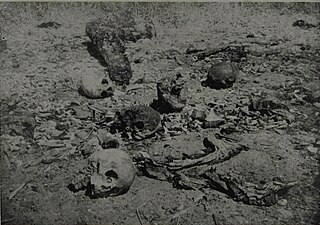
Shah Alam II, also known by his birth name Ali Gohar, or Ali Gauhar, was the seventeenth Mughal emperor and the son of Alamgir II. Shah Alam II became the emperor of a crumbling Mughal Empire. His power was so depleted during his reign that it led to a saying in the Persian language, Sultanat-e-Shah Alam, Az Dilli ta Palam, meaning, 'The empire of Shah Alam is from Delhi to Palam', Palam being a suburb of Delhi.

Najib ad-Dawlah, also known as Najib Khan Yousafzai, was a Rohilla Yousafzai Afghan who earlier served as a Mughal serviceman but later deserted the cause of the Mughals and joined Ahmed Shah Abdali in 1757 in his attack on Delhi. He was also a House chief of Rohilkhand, and in the 1740s founded the city of Najibabad in Bijnor district, India. He was instrumental in winning the Third Battle of Panipat.

Jassa Singh Ramgarhia (1723–1803) was a prominent Sikh leader during the period of the Sikh Confederacy. He was the founder of the Ramgarhia Misl.

Sultan-ul-Qaum Sardar Jassa Singh Ahluwalia was a Sikh leader during the period of the Sikh Confederacy, being the Supreme Leader of the Dal Khalsa. He was also Misldar of the Ahluwalia Misl. This period was an interlude, lasting roughly from the time of the death of Banda Bahadur in 1716 to the founding of the Sikh Empire in 1801. He founded the Kapurthala State in 1772.
Sardar Hari Singh Dhillon was an 18th century Sikh warrior and the chief of Bhangi Misl. During the formation of the Dal Khalsa he was acknowledged as leader of Tarna Dal, and he was made chief of Bhangi Misl following the death of Bhuma Singh Dhillion, who he was the adopted son of, in 1748. Hari Singh made the Bhangi Misl the most powerful of all the Misls. He was described as brave and fearless as well as a great warrior.

Baghel Singh was a Military general in the Punjab region in the northern part of the Indian subcontinent in the 18th century. He rose to prominence in the area around Sutlej and Yamuna. He joined the Singh Krora Misl, one of the misls during Sikh Confederacy. In 1765, Singh became the leader of the misl.

Vadda Ghalughara was the mass murder of unarmed Sikhs by the Afghan forces of the Durrani Empire during the years of Afghan influence in the Punjab region of the Indian subcontinent owing to the repeated incursions of Ahmad Shah Durrani in February 1762. It is distinguished from the Chhota Ghalughara. Mostly non-combatants were killed in the event, and an estimated that 10,000 to 50,000 Sikhs were killed on 5 February 1762.
Zain-ud-Din Khan known as Zain Khan Sirhindi was the Mughal Faujdar of Sirhind, he was a serviceman of Shah Alam II, an ally of Najib-ud-Daula and Ahmad Shah Durrani. Zain Khan Sirhindi fought during the Third Battle of Panipat and strengthened Mughal rule in the region.

The Afghan-Maratha War was fought between the Afghan Empire under Ahmad Shah Durrani and the Maratha Empire and the Sikh Confederacy between 1758 and 1761. It took place in north-west India, primarily the region around Delhi and Punjab.
The Battle of Kup was fought on 5 February 1762, between the Afghan forces of Ahmad Shah Durrani and the Sikhs, under the command of Jassa Singh Ahluwalia and Charat Singh. Ahmad Shah Durrani and the Afghan forces reached Malerkotla, west of Sirhind. They were met by between 30,000—50,000 Sikhs. Abdali's forces outnumbered the Sikhs in hand-to-hand combat and the Sikhs couldn't use their usual tactics of hit and run, but had to engage in battle while protecting the civilians at the same time. The Sikhs created a human ring around civilians as protection and fought the battle as they advanced towards Barnala. Abdali was able to break the ring and carried out a full scale massacre of the Sikh civilians. Ahmad Shah's forces killed several thousand Sikhs, and the surviving Sikhs fled to Barnala. According to various different estimates, as many as 5,000 to 30,000 Sikh men, women, elderly and children were killed in what is known as the second Sikh genocide.
The Battle of Sialkot took place on 12 November 1763, between the Durrani Empire, led by Jahan Khan, and the Sukerchakia Misl, led by Charat Singh, as part of the Afghan-Sikh wars which concluded with Sikh victory.

Ahmad Shah Durrani, the founder of the Durrani Empire, invaded Indian subcontinent for eight times between 1748 and 1767, following the collapse of Mughal Empire in the mid-18th century. His objectives were met through the raids and deepened the political crisis in India.
The Battle of Harnaulgarh was fought between the Durrani Empire and the Sikh Misls of Dal Khalsa in 1762.
Sardar Chuhar Singh of Jharauli was a general of Shaheedan Misl. He was the paternal cousin of Rai Singh Bhangi and close relative of Sikh warrior Baba Deep Singh. Under the command of Jassa Singh Ahluwalia, he fought for Shaheedan Misl in the Battle of Sirhind (1764) against Mughal Faujdar of Sirhind, Zain Khan Sirhindi. He secured Jharauli, Fatehgarh Atri, Ajrana and seven other villages by Markanda River. He had two sons, Karam Singh and Mohar Singh. The younger Mohar Singh took charge of the Jharauli estate. His elder son Karam Singh took control of the family estate at Chung that was finally incorporated to Lahore Darbar by issueless Ranjit Singh after his death in 1808. Mohar Singh lost seven villages of the Jharauli estate to Bhunga Singh of Thanesar in 1780. The Jharauli estate remained under the Court of Wards during 1885-1893 and again between 1922-1947.
Sikh attacks on Delhi were common in the second half of the 18th century. The Sikhs attacked Delhi 19 times between 1766 and 1788.
The Battle of Mahilpur was fought between the Sikh Misls and Adina Beg Khan against the Durrani Empire in December 1757.Following the 4th invasion of Ahmad Shah Durrani, he would appoint Timur Shah as the viceroy of Punjab with Jahan Khan as his deputy.The Afghans would appoint Adina Beg Khan as the faujdar of the Jalandhar Doaba and exempted him from attending court at lahore, on the condition that Adina Beg pay revenue to the Afghan government.Soon a dispute regarding the payment of revenue occurred between Adina Beg and the Afghans.This dispute soon escalated which resulted in Jahan Khan sending an Afghan force to arrest Adina Beg.Adina Beg formed a military alliance with the Sikhs under the command of Jassa Singh Ahluwalia and Vadbhag Singh Sodhi.Adina Beg also gained the support of Sadiq Beg Khan, Khwaja Mirza Khan, and Raja Bhup Singh.Adina Beg along with the Sikh forces fought the Afghans at Mahilpur.The battle resulted in a victory for Adina Beg and the Sikhs and resulted in the entire Jalandhar Doaba being occupied and sacked by the Sikh forces.
The Battle of Darbar Sahib was fought in 1764, during the Afghan-Sikh Wars, between the Shaheedan Misl of the Sikhs and the Durrani Empire of Ahmad Shah Abdali aided by the Khanate of Kalat.
The Raid of Panipat (1770) was a raid on 4 January 1770 by the Sikh forces led by Jassa Singh Ahluwalia against the Mughal forces led by Zabita Khan.
The Battle of Chamkaur was fought in January 1764 by Sikh forces led by Jassa Singh Ahluwalia and Afghan forces led by Lachhmi Narain.
The Second Sikh Invasion of Rohilkhand took place in late 1764 while Najib ad-Dawlah was being besieged in Delhi by Jawahar Singh of Bharatpur, offering Sikhs to invade the unprotected Rohilla estates led by Jassa Singh Ahluwalia.








